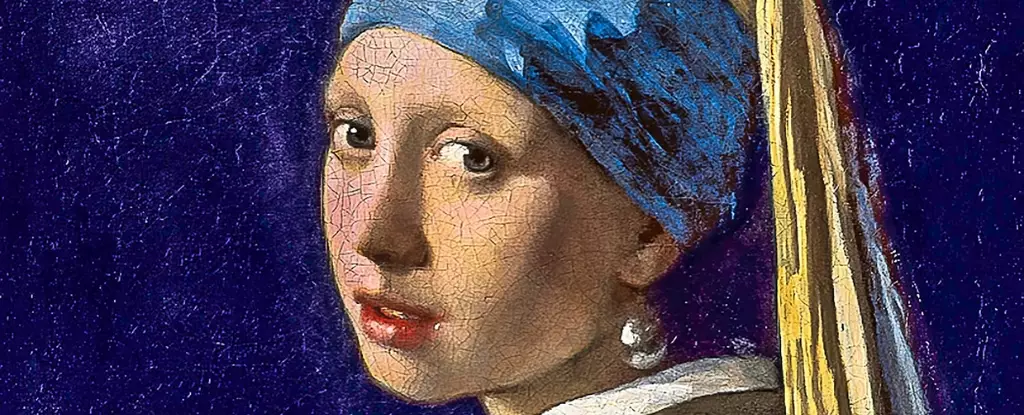Johannes Vermeer’s “Girl With a Pearl Earring” stands as a hallmark of artistic brilliance and cultural significance. Unlike any painting of its time, it has gained a unique status in art history, prompting admiration and curiosity from countless art lovers and critics alike. Recent scientific inquiries have delved into the reasons behind its unprecedented allure. Research conducted at the Mauritshuis museum in The Hague has utilized advanced neuroscientific methods to uncover the neurologically captivating qualities of this 17th-century masterpiece.
The study, undertaken by neuroscientists at Neurensics, has introduced a groundbreaking concept called the “Sustained Attentional Loop.” This phenomenon posits that the viewer’s gaze is instinctively guided through specific focal points of the painting: starting at the girl’s captivating eye, then transitioning to her mouth, moving to the luminous pearl, and finally returning to her eye. This cyclical gaze not only draws viewers in but also prolongs their engagement with the artwork. Neuroscientist Martin de Munnik highlights this unique engagement, stating, “You have to pay attention whether you want to or not. You have to love her whether you want to or not.” This consistent redirection of focus appears to create an involuntary attraction that reinforces the painting’s popularity and centrality in art discussions.
Brain Function and Emotional Engagement
The relevance of the precuneus, a brain region integral to consciousness and personal identity, emerged as a key finding in the study. The increased activity in this area suggests that viewing the “Girl With a Pearl Earring” is not just a visual experience; it also evokes deep personal reflections in the viewer. De Munnik notes the unexpected depth of the neurologically observed responses, shedding light on why this painting engenders a more profound experience than others. The interaction of eye movement and emotional response indicates that prolonged observation may enhance perceptions of beauty and attractiveness, offering insights into the painting’s enigmatic charm.
Another focal point of the research was the contrast between the emotional responses elicited by original art pieces versus reproductions. Scientists discovered that the emotional impact of viewing the actual painting was exponentially greater—tenfold—compared to merely observing a print. Mauritshuis Director Martine Gosselink emphasized the importance of experiencing original art. “It really helps to develop your brain… The brain doesn’t lie,” she explains, illustrating the profound and transformative experiences that direct engagement with art can cultivate. This revelation underscores the necessity of art institutions maintaining and promoting access to genuine works of art, enhancing public appreciation for historical pieces.
Vermeer’s artistic technique further contributes to the painting’s intrigue. Known for illuminating specific details while softening the background, Vermeer directs the observer’s attention masterfully. Unlike many of his other works, which typically depict subjects engaged in daily tasks, the “Girl With a Pearl Earring” presents an unmistakable connection with the viewer. The girl’s direct gaze and the tripartite focus on her eye, mouth, and the striking pearl create a compelling dialogue between the subject and the observer. Gosselink emphasizes how this deliberate positioning sets the painting apart and contributes to its lasting impact.
The revelations stemming from the study raise intriguing questions about the potential of further neurologically based explorations into other iconic artworks, such as Leonardo da Vinci’s “Mona Lisa.” De Munnik expresses enthusiasm for such endeavors, which may clarify the emotional connections inherent in other pieces throughout art history. Gosselink humorously acknowledges the informal competition between these masterpieces, pointing out that while the “Girl With a Pearl Earring” is sometimes dubbed “the Mona Lisa of the North,” the evolving appreciation for both could reshape cultural narratives.
The intersection of artistry and neuroscience highlights how deeply ingrained our responses to artwork can be. Vermeer’s “Girl With a Pearl Earring” exemplifies a unique blend of aesthetic beauty, psychological resonance, and emotional engagement. As science continues to illuminate our understanding of art, it underscores its vital role in enriching human experience and revealing the myriad ways in which we connect with the world around us. This lingering dialogue between viewers and masterpieces forms an essential part of the human condition, reminding us of the timeless power of art in shaping our perceptions and emotions.


Leave a Reply